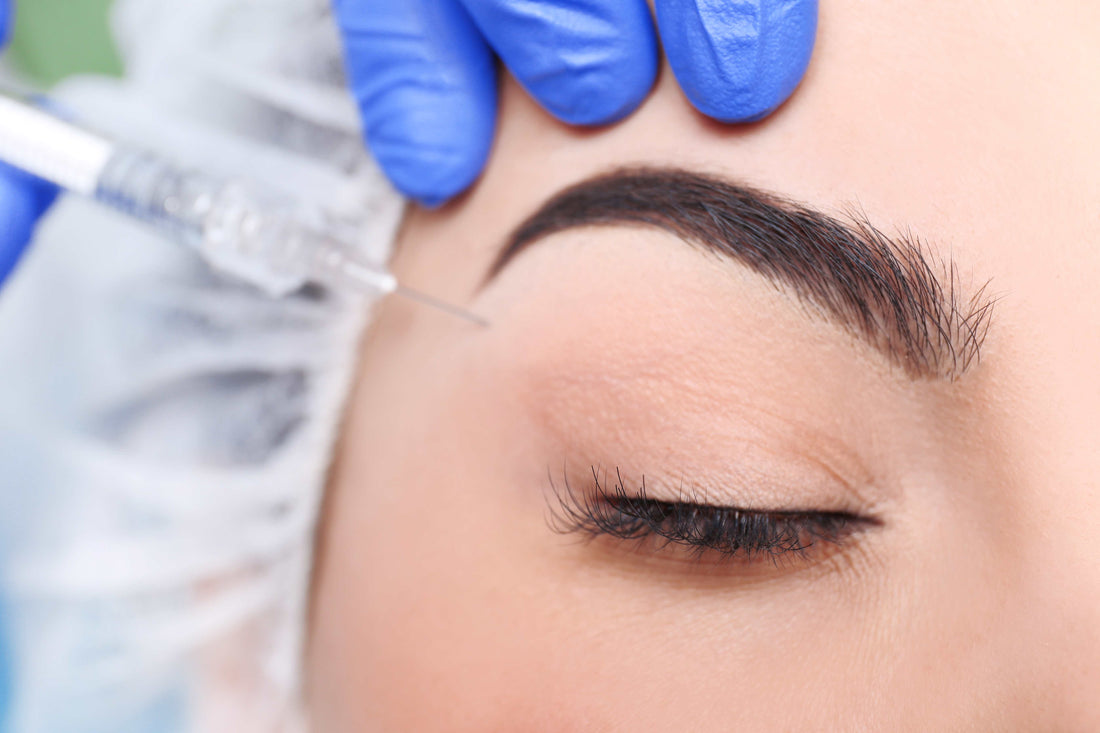
Anti-wrinkle injections 101
Research has found that two-thirds of Irish people open to trying Botox, and globally, we are not alone.* Botox (BTX) is a brand of anti-wrinkle injectable and is the most common non-surgical procedure for both men and women across all age groups, with more than seven million procedures performed by plastic surgeons worldwide but what is Botox and how do you know if it is suitable for you? The SKINday Time talks to Aesthetic Injector Dr Mairead Browne and Professor Caitriona Ryan of the Institute of Dermatologists, Ireland about the increasingly popular injectable.
What is Botox?
‘Botox is a neurotoxin produced by the bacterium Clostridium Botulinum; a gram-positive anaerobe found in soil,’ says Dr Browne. ‘It blocks nerve signals to the muscles in which it is injected and is most commonly used to reduce the appearance of wrinkles in the forehead, crow’s feet around the eyes and the frown lines. It blocks the pre-synaptic nerve synapses preventing the release of neurotransmitter acetylcholine at the neuromuscular junction reducing muscle activity and weakening the affected muscle. It temporarily paralyses/relaxes, reducing the contraction of the facial muscles and alleviates the wrinkling of the overlying skin. It was first used medically, to treat strabismus, squinting and spasticity disorders and was FDA approved for cosmetic use for treating the glabellar since 2002.’
How is Botulinum toxin different to dermal fillers?
‘Botulinum toxin (anti-wrinkle) injections can reduce wrinkles while strategically relaxing certain muscle groups to help elevate the brow, open the eyes, soften the chin, and reduce the pull of the neck bands on the jawline,’ explains Professor Ryan. ‘Effective, well-placed injections should be subtle and leave a patient looking fresher and more relaxed. Dermal fillers, on the other hand, can help to restore volume and reverse the structural changes in the aging face, restoring the aesthetically sought after ratios and dimensions of youth in the most natural way. Hyaluronic acid dermal fillers have revolutionised non-surgical volume enhancement of the face and can be used to improve many age-related changes. We use them to augment the cheeks and restore youthful fullness, fill out gauntness in the lower cheek or temple area, plump thin wrinkled lips, smooth out the vertical lines which appear around the edges of the lips, and to fill out hollows under the eye area (tear troughs). Even more valuable in perimenopausal patients is the bio stimulating pan-facial dermal filler Sculptra which enhances collagen production throughout the face while restoring volume to tighten and strengthen the skin and underlying tissues.’
Are botulinum toxin injections safe?
‘Yes,’ comments Dr Browne. ‘Botox is a relatively safe treatment when performed by an experienced practitioner. Botox is an FDA approved, low-risk treatment with a good safety profile and good evidence base. There are no long term or life threating adverse effects related to Botox injections for cosmetic indications.’
Are there any contraindications to Botox?
There are a few including: active infection at the planned site of injection, inflammatory skin conditions at the site of injection (e.g. Psoriasis and dermatitis), history of allergy to BTX injection or any of its other constituents (i.e. Alblumin), neuromuscular conditions and neuropathies e.g. Motor Neurone disease or Eaton-Lambert syndrome, previous eyelid surgery as use of BTX may increase risk of ectropion, pregnancy and lactation, Body Dysmorphic Disorder diagnosis and medications such as antiplatelets or anticoagulants and those acting at the neuromuscular junction e.g. Aminoglycosides, Penicillinamine, Quinine and Chloroquinine.
What is the best age to start?
Botox is approved for patients who are 18 years and above, but most experts agree mid to late twenties or early thirties is a good age to start preventative Botox. There is no upper age limit for people who want to start Botox. ‘The best time depends on your skin and biological age rather than chronological age,’ Comments Dr Browne. ‘When you smile or frown, we develop lines during expression, which go away when the face is relaxed, when the earliest fine lines start to remain at rest this is a good time to consider anti-wrinkle injections as it is easier to prevent the signs of ageing.’
Which areas of muscle can be treated with Botox?
Botox can be used to treat muscles in the upper and lower face, ‘We can use it to treat and soften lines in the glabellar (horizontal indentations that stretch across your forehead), around the eyes, for a brow lift, to treat bunny lines (fine wrinkles that appear when you scrunch up your nose, such as when you laugh or smile deeply), for facial slimming, to reduce a ‘Gummy’ smile, smokers line prevention or lip flip, to smooth chin dimpling and to treat horizontal lines (platysmal bands) in the neck,’ Dr Browne lists. ‘Botox can also be used for migraine treatment and to treat hyperhidrosis (excessive sweating) by injecting the underarm area.’
Does Botox need to be administered by a medical professional?
Yes. In Ireland under current regulations Botox can only be administered by a doctor or dentist. There are many unlicensed brands often administered by practitioners with no medical training. If a medicine is not authorised, there’s no guarantee that it meets the quality, safety and effectiveness standards.
How long does it take for anti-wrinkle injections to start working and how long should it last?
Anti-wrinkle injectables usually start working from day 3-4 after treatment with maximum results on day 14. Longevity is dose dependent, so if you had a lower dose or a more relaxed look then you can expect it to last between 12- 16 weeks. A number of factors impact longevity. Every patient metabolises anti-wrinkle injectables at a different rate and factors such as muscle size and activity, number of treatments you receive, and age can make a difference.
How long is the recovery?
‘It’s a fast, effective treatment with minimal recovery time, meaning that you may resume normal activities immediately, but you should avoid lying down for 4-6 hours, avoid massage on the injected area and wearing makeup for 24 hours. You should also avoid alcohol, UV exposure, excessive heat and saunas for 24 hours,’ recommends Dr Browne. ‘Most immediate side effects are well localised, reversible and self-limiting. These include pain, swelling or bruising at the injection site, headache and flu-like symptoms and eyelid and eyebrow ptosis. Most adverse effects will present themselves within the first week post treatment.’
What are the signs of a negative anti-wrinkle treatment?
‘Eyelid or eyebrow ptosis are complications after injections, and this is why the most important thing you should do to prevent this is work with an experienced medical professional with extensive knowledge of facial anatomy. Eyebrow and eyelid ptosis are two separate complications:
Eyebrow ptosis is a drooping of the eyebrow area due to over treatment of the frontalis muscle resulting in no movement of the eyebrows. According to research, brow ptosis occurs after forehead treatment with botulinum toxin with a frequency of around 1-5%.* This is caused, often, by using incorrect injection sites, too high dosages, and by an inappropriate selection of patients This will resolve over a few months and your practitioner can give you balancing injections to counteract this.
Eyelid ptosis is a drooping of the upper eyelid and is a more serious complication, that can result from the diffusion of toxin through orbital septum affecting the levator palpebrae muscle. from the corrugator muscle. It has an incidence of 1 in 100 and can last 4-6 months with more rare cases lasting up to a year. Any asymmetry arising from toxin treatment is temporary and can be balanced out with additional anti-wrinkle injections,’ says Dr Browne.
* Redaelli A, Forte R. How to avoid brow ptosis after forehead treatment with botulinum toxin. J Cosmet Laser Ther. 2003 Dec;5(3-4):220-2. doi: 10.1080/14764170310023254. PMID: 14741838.
